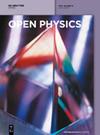优化带有等温固体块的可渗透空腔中的热传输:纳米颗粒体积分数和壁速比的影响
IF 1.8
4区 物理与天体物理
Q2 PHYSICS, MULTIDISCIPLINARY
引用次数: 0
摘要
本研究探讨了壁面速度比对中心含有等温固体块的可渗透空腔中混合对流热传输的影响。分析考虑了各种流动变量(即达西数、壁面速度比、理查森数和悬浮纳米颗粒的体积分数)对热传输和材料流动特性的影响。主要方程采用压力关联方程算法的半隐式法求解,并将结果与现有文献进行比较。研究表明,提高达西数、速度比、理查德森数和纳米颗粒体积分数的估算值可提高传热率。例如,在理查德森数(100)和固体体积分数(0.05)较高的情况下,将速度比从 0.5 提高到 1.5 会导致热传导率上升 6%(5%)。相反,在较小的理查德森数(0.01)条件下,热传导率上升了 29%(28%)。同样,在高达西数和低壁速比条件下,随着纳米颗粒浓度从 0 增加到 0.05,热传输速率上升了 3%(4%),而在低达西数条件下,热性能提高了 9%(8%)。该研究强调了优化纳米颗粒体积分数、达西数、速度比和理查森数组合的重要性,以最大限度地提高多孔空腔的热性能。本文章由计算机程序翻译,如有差异,请以英文原文为准。
Optimizing heat transport in a permeable cavity with an isothermal solid block: Influence of nanoparticles volume fraction and wall velocity ratio
This study examines the influence of wall velocity ratio on mixed convective heat transport in a permeable cavity containing an isothermal solid block at its center. The analysis considers the characteristics of various flow variables, i.e ., Darcy number, wall velocity ratio, Richardson number, and volume fraction of suspended nanoparticles, on heat transport and material flow characteristics. The principal equations are solved implementing the semi-implicit method for pressure linked equations algorithm, and the outcomes are compared with existing literature. The study shows that rising estimations of Darcy number, velocity ratio, Richardson number, and nanoparticles volume fraction lead to improved heat transfer rates. For example, at high Richardson number (100) and solid volume fraction (0.05), increasing the velocity ratio from 0.5 to 1.5 results in a 6% (5%) upsurge in heat transport rate. Conversely, at smaller Richardson number (0.01), the heat transport rate upsurges by 29% (28%). Similarly, at high Darcy numbers and low wall velocity ratios, a 3% (4%) escalate in heat transport rate is observed with an increase in nanoparticles concentration from 0 to 0.05, while a 9% (8%) increase in thermal performance is achieved at low Darcy numbers. The study emphasizes the importance of optimizing the combination of nanoparticles volume fraction, Darcy number, velocity ratio, and Richardson number to maximize thermal performance in the porous cavity.
求助全文
通过发布文献求助,成功后即可免费获取论文全文。
去求助
来源期刊

Open Physics
PHYSICS, MULTIDISCIPLINARY-
CiteScore
3.20
自引率
5.30%
发文量
82
审稿时长
18 weeks
期刊介绍:
Open Physics is a peer-reviewed, open access, electronic journal devoted to the publication of fundamental research results in all fields of physics. The journal provides the readers with free, instant, and permanent access to all content worldwide; and the authors with extensive promotion of published articles, long-time preservation, language-correction services, no space constraints and immediate publication. Our standard policy requires each paper to be reviewed by at least two Referees and the peer-review process is single-blind.
 求助内容:
求助内容: 应助结果提醒方式:
应助结果提醒方式:


